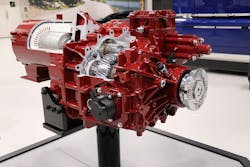Mack’s new electric truck to clear NYC trash without polluting air
ALLENTOWN, PA – Mack Trucks, the leading refuse truck manufacturer, has officially unveiled the company's first ever battery electric refuse truck, the LR Electric model, at its Customer Center, offering test drives to the media and its first customer, the New York City Department of Sanitation. The world’s largest sanitation department, which collects 10,500 tons of refuse and 1,700 tons of recyclables a day, will start with five routes throughout Brooklyn in the spring.
For Mack, it’s a chance to challenge the 72,000-lb. (GVW) truck’s capabilities in one of the most demanding environments out there. For the DSNY, adding more zero-emissions vehicle will inch New York City closer to Mayor Bill de Blasio’s target of reducing greenhouse gas emissions by 80% by the year 2035. The city aims to become carbon neutral by 2050.
“DSNY, along with our more than 6,000 vehicles, will play a major role as we push toward that goal,” said DSNY Deputy Commissioner Rocky DiRico. “We’re looking at all kinds of technologies to help us achieve that reduction. We’re especially proud to be the first Mack customer to test the LR Electric model.”
DSNY’s collection truck fleet, comprising 2,346 vehicles, is 99% Mack. The department has been at the forefront of advanced fuel technology, implementing compressed natural gas (CNG) in 1989, EV in 1999, and adding biodiesel and even dimethyl ether along the way. The LR Electric marks the first battery electric refuse vehicle in its fleet.
“We took some baby steps along the way, but this is a giant step,” DiRico remarked.
DiRico, part of a large contingent of DSNY leadership and engineers, was also the first of the day to test the LR Electric.
After climbing down from the cab he said, “Unbelievable, all you hear is a little squeak here or there and that’s it.
Those intermittent high-pitched sounds would normally be covered by the rumbling diesel engine, Mack lead engineer for the project, Ed Strauss, said.
“The Mack LR Electric demonstrates Mack’s leadership in powertrain innovation, bringing clean, quiet propulsion to the refuse application, which is one of the toughest in heavy-duty trucking due to the harsh operating environments and number of starts and stops during a shift,” said Jonathan Randall, Mack Trucks senior vice president, North American sales and marketing.
The truck is basically the diesel-powered version of the LR, launched in 2015. The powered source is four NMC lithium-ion batteries (Lithium Nickel Manganese Cobalt Oxide), which take as little as 90 minutes to charge, using a 50kW, SAE J1772-compliant charging system. The regenerative braking system diverts the kinetic energy generated by stopping to the battery to recycle some of that expended energy.
The drivetrain, developed through the shared Volvo Group’s global technology network, includes a 130-kW motor that deliver a combined 496-peak horsepower, providing 4,051 lb.-ft. of torque available from zero RPM. The two-speed Mack Powershift transmission channels that power to the road via Mack’s proprietary S522R 52,000-lb. rear axles.
This unit no. 1 will be taken over to Brooklyn for some initial street tests before heading south to Greensboro for any tweaking that comes from DSNY feedback. The next few months will be full of “testing and piloting and beating the hell out of that truck,” DiRico said, to ensure it has the rough-and-tumble personality to make it in the streets of the city that never sleeps.
The LR Electric as it is currently configured will not be able to also plow the various boroughs’ streets, which current refuse trucks are responsible for. They must clear 6,300 miles of road, and Mack needs to know the truck can effectively complete its primary mission before multitasking.







